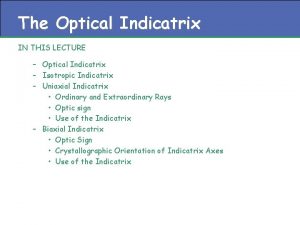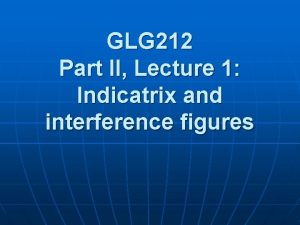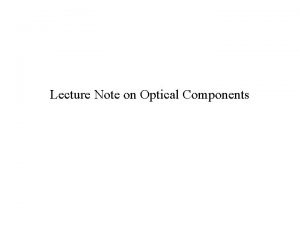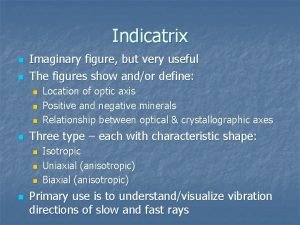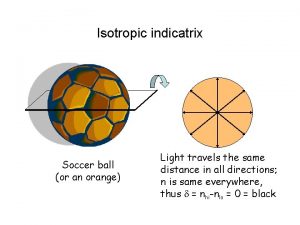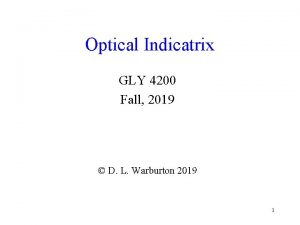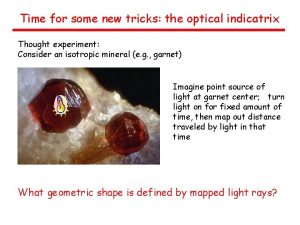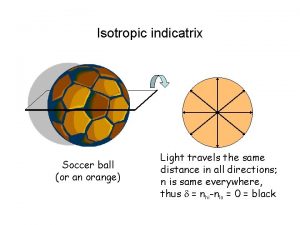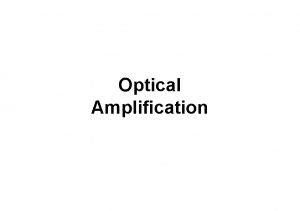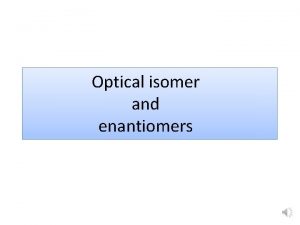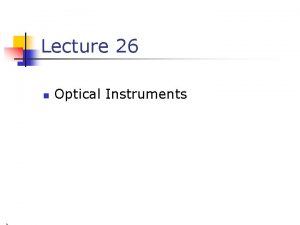The Optical Indicatrix IN THIS LECTURE Optical Indicatrix



























- Slides: 27

The Optical Indicatrix IN THIS LECTURE – Optical Indicatrix – Isotropic Indicatrix – Uniaxial Indicatrix • Ordinary and Extraordinary Rays • Optic sign • Use of the Indicatrix – Biaxial Indicatrix • Optic Sign • Crystallographic Orientation of Indicatrix Axes • Use of the Indicatrix

The Optical Indicatrix • A geometric figure that shows the index of refraction and vibration direction for light passing in any direction through a material is called an optical indicatrix. • The indicatrix is constructed by plotting indices of refraction as radii parallel to the vibration direction of the light. • Ray p, propagating along Y, vibrates parallel to the Z-axis so its index of refraction (np) is plotted as radii along Z. • Ray q, propagating along X, vibrates parallel to Y so its index of refraction (nq) is plotted as radii along Y. • If the indices of refraction for all possible light rays are plotted in a similar way, the surface of the indicatrix is defined. The shape of the indicatrix depends on mineral symmetry.

Constructing an Optical Indicatrix • The primary use of the indicatrix is to determine the indices of refraction and vibration directions of the slow and fast rays given the wave normal direction followed by the light through the mineral. • The basic steps are: 1. Construct a section through the indicatrix at right angles to the wave normal. This section is parallel to the wave front. In the general case, the section through the indicatrix is an ellipse. 2. The axes of the elliptical section are parallel to the vibration directions of the slow and fast rays and the lengths of radii parallel to those axes are equal to the indices of refraction.

Optical Indicatrix with Wave Normal • • Shown is an indicatrix showing a wave normal direction (WN) along which the light propagates. An elliptical section through the indicatrix perpendicular to the wave normal is parallel to the wave front. The long axis of this elliptical section is parallel to the slow ray vibration direction and the radius parallel to this direction is equal to the slow ray index of refraction (nslow). The short axis of the elliptical section is parallel to the fast ray vibration direction and the radius parallel to this direction is equal to the fast ray index of refraction (nfast).

Ray Paths for Optical Indicatrix • • To find the ray paths, which are paths followed by an image through the mineral such as those seen with the calcite rhomb, tangents to the indicatrix are constructed parallel to the vibration directions of the slow and the fast rays. In the general case in which the indicatrix is a triaxial ellipsoid, both rays diverge from their associated wave normals.

Isotropic Indicatrix • • • Optically isotropic minerals all crystallise in the isometric crystal system. One unit cell dimension (a) is required to describe the unit cell and one index of refraction (n) is required to describe the optical properties because light velocity is uniform in all directions for a particular wavelength of light. The indicatrix is therefore a sphere. All sections through the indicatrix are circles and the light is not split into two rays. Birefringence may be considered to be zero.

Uniaxial Indicatrix • • • Minerals that crystallize in the tetragonal and hexagonal crystal systems have two different unit cell dimensions (a and c) and a high degree of symmetry about the c axis. Two indices of refraction are required to define the dimensions of the indicatrix, which is an ellipsoid of revolution whose axis is the c crystal axis. The semiaxis of the indicatrix measured parallel to the c axis is called ne, and the radius at right angles is called nw. The maximum birefringence of uniaxial minerals is always [ne - nw]. All vertical sections through the indicatrix that include the c axis are identical ellipses called principal sections whose axes are nw and ne. Random sections are ellipses whose dimensions are nw and ne’ where ne’ is between nw and ne. The section at right angles to the c axis is a circular section whose radius is nw. Because this section is a circle, light propagating along the c axis is not doubly refracted as it is following an optic axis. Because hexagonal and tetragonal minerals have a single optic axis, they are called optically unixial.

Ordinary and Extraordinary Rays • • Recall that if a cleavage rhomb of calcite is placed on a dot or other image on a piece of paper, two images appear, each composed of planepolarised light vibrating at right angles to the other. The light passing up through the calcite can be considered to be incident at right angles. Based on Snell’s Law, the wave normal for this light is not bent, it remains perpendicular to the bottom surface of the rhomb. When light moves in uniaxial crystals in any direction other than parallel to the c axis, it is broken into two rays travelling with different velocities, what we have previously called the fast ray and the slow ray. One of these rays vibrates in the basal plane whilst the other vibrates at right angles to it and thus in a plane that includes the c axis, ie a principal section. The ray, whose waves vibrate in the basal plane is called the ordinary (e) ray whilst the ray whose waves vibrate in a principal section is called the extraordinary (w) ray. To determine whether the extraordinary ray is the fast or the slow ray we need to know the optic sign of the mineral.

Ordinary Rays • • • Ordinary rays or e rays have waves vibrating in the basal plane, which is represented by a sphere and thus all the waves travel the same distance in the same time. They thus behave in an ordinary manner. Put another way all ordinary rays have the same velocity and thus the same index of refraction. The ordinary ray vibration vector is always parallel to the (001) plane in uniaxial minerals which is the only plane in which electron density is uniform. Regardless of propagation direction one of the two rays produces as a consequence of double refraction in unaxial minerals is always an ordinary ray. If the calcite rhomb is rotated about a vertical axis, the position of the ordinary ray image remains fixed.

Extraordinary Rays • • • Extraordinary rays or w rays have waves vibrating in a principal section, which is represented by an ellipsoid and thus the waves travel different distances in the same time depending on the orientation of the incident beam. They are called extraordinary rays because the ray path and the wave normal do not coincide. The wave normal for an extraordinary ray is parallel to the normally incident light striking the bottom of the mineral, in this case calcite, and it therefore coincident with the ordinary ray and wave normal. However, the extraordinary ray path diverges from the wave normal The index of refraction of extraordinary rays varies with direction between nw and ne where ne may be either higher or lower than nw. For any propagation direction except perpendicular to the c axis, the index of refraction of the extraordinary ray is designated ne’ and is between nw and ne.

Optic Sign – Uniaxial Minerals • • The dimensions of the indicatrix along the c axis may be either greater or less than the dimensions at right angles. We can use this to define the optic sign in uniaxial minerals 1. In optically positive minerals, ne is greater than nw and thus the extraordinary rays are slow rays. 2. In optically negative minerals, ne is less than nw and thus extraordinary rays are fast rays.

Uniaxial Indicatrix - Positive • Thus if the uniaxial mineral is optically positive it will be shaped like a prolate spheroid

Uniaxial Indicatrix - Negative • If the mineral is optically negative the indicatrix will be shaped like an oblate spheriod

Use of the Indicatrix • • • We can now examine the behaviour of light passing through grains of a uniaxial minerals in different orientations either in a thin section or a grain mount. Orthoscopic illumination is used (ie auxilliary condenser lens removed) so that the light strikes the bottom surface of the sample more or less normal to the surface. This means that the wave normal of the light entering the mineral is not bent and the wave front is parallel to the bottom surface of the mineral.

Use of the Indicatrix • • • In this example the mineral is oriented so that its optic axis is horizontal. We will assume that the mineral is uniaxial positive The wave normal is through the centre of the indicatrix and light is incident normal to the bottom surface of the grain. Because the optic axis is horizontal, this section is a principal section, which is an ellipse whose axes are nw and ne. The ordinary ray therefore has index of refraction nw and the extraordinary ray ne, which is its maximum because the mineral is optically positive. The extraordinary ray vibrates parallel to the trace of the optic axis (c axis) and the ordinary ray vibrates at right angles. Therefore, birefringence and hence interference colors are maximum values.

Use of the Indicatrix • • • In this case the mineral sample is oriented so that the optic axis is vertical. The section through the indicatrix perpendicular to the wave normal is the circular section whose radius is nw. Light coming from below is not doubly refracted, birefringence is zero and the light preserves whatever vibration direction it initially had. Between crossed polars this mineral should behave like an isotropic mineral and remain dark as the stage is rotated. However, because the light from the substage condenser is moderately converging, some light may pass through the mineral. The mineral may display interference colors but they will be the lowest order found in that mineral.

Use of the Indicatrix • • In this sample the mineral sample is oriented in a random orientation so that the light path is at an angle q to the optic axis. The section through the indicatrix parallel to the bottom surface of the mineral is an ellipse whose axes are nw and ne’. The extraordinary ray vibrates parallel to the trace of the optic axis as seen from above, while the ordinary ray vibrates at right angles Both birefringence and interference colors are intermediate because ne’ is intermediate between nw and ne.

Biaxial Indicatrix • Minerals that crystallise in the orthorhombic, monoclinic and triclinic crystal systems require three dimensions (a, b and c) to describe their unit cells and three indices of refraction to define the shape of their indicatrix. • The three principal indices of refraction are na, nb and ng where na < nb < ng. The maxmium birefringence of a biaxial mineral is always ng - na Construction of a biaxial indicatrix requires that three indices of refraction are plotted However, while three indices of refraction are required to describe biaxial optics, light that enters biaxial minerals is still split into two rays. As we shall see, both of these rays behave as extraordinary rays for most propagation paths through the mineral. The wave normal and ray diverge like the extraordinary ray in uniaxial minerals and their indices of refraction vary with direction, the same of the fast and slow rays that we are familiar with. • • • The index of refraction of the fast ray is identified as na’ where na < na’ < nb and the index of refraction of the slow ray is ng’ where nb < ng’ < ng

Biaxial Indicatrix – (1) • • The biaxial indicatrix contains three principal sections, the YZ, XY and XZ planes. The XY section is an ellipse with axes na and nb, the XZ section is an ellipse with axes na and ng and the YZ section is an ellipse with axes nb and ng. Random sections through the indicatrix are ellipses whose axes are na’ and ng’. The indicatrix has two circular sections with radius nb that intersect the Y axis. The XZ plane is an ellipse whose radii vary between na and ng. Therefore radii of nb must be present. Radii shorter than nb are na’ and those that are longer are ng’. The radius of the indicatrix along the Y axis is also nb

Biaxial Indicatrix – (2) • • • Therefore the Y axis and the nb radii in the XZ plane define the two circular sections. Like uniaxial minerals, the circular sections in biaxial minerals are perpendicular to the optic axes, hence the term biaxial. Because both optic axes lie in the XZ plane of the indicatrix, that plane is called the optic plane. The angle between the optic axes bisected by the X axis is also called the 2 Vx angle, while the angle between the optic axes bisected by the Z axis is called the 2 Vz angle where 2 Vx + 2 Vz = 180°. The Y axis, which is perpendicular to the optic plane is called the optic normal.

Optic Sign – Biaxial Minerals • • The acute angle between the optic axes is called the optic angle or 2 V angle. The axis (either X and Z)that bisects the optic angle is the acute bisectrix or Bxa. The axis (either Z or X) that bisects the obtuse angle between the optic axes is the obtuse bisectrix or Bxo. The optic sign of biaxial minerals depends on whether the Z or Z indicatrix axis bisects the acute angle between the optic axes. 1. If the acute bisectrix is the X axis, the mineral is optically negative and 2 Vx is less than 90° 2. If the acute bisectrix is the Z axis, the mineral is optically positive and 2 Vz is less than 90° 3. If 2 V is exactly 90° so neither X nor Z is the acute bisectrix, the mineral is optically neutral.

Optic Sign and Biaxial Indicatrix

Crystallographic Orientation of Indicatrix Axes • • The term optic orientation refers to the relationship between indicatrix axes and crystal axes. Because the optical properties of minerals are directly controlled by the symmetry of the crystal structure, optic orientation must be consistent with mineral symmetry.

Indicatrix Axes and Orthorhombic Crystals • • Orthorhombic crystals have three mutually perpendicular crystallographic aces of unequal length. These crystal axes must coincide with the three indicatrix axes and the symmetry planes in the mineral must coincide with principal sections in the indicatrix. Any crystal axis may coincide with any indicatrix axis however. The optic orientation is defined by indicating which indicatrix axis is parallel to which mineral axis. 1. Aragonite X = c, Y = a, Z = b 2. Anthophyllite X = a, Y = b, Z = c

Indicatrix Axes and Monoclinic Crystals • • In monoclinic minerals, the b crystallographic axis coincides with the single 2 -fold rotation axis and/or is perpendicular to the single mirror plane. The a axes and c axes are perpendicular to b and intersect in an obtuse angle. One indicatrix axis, which could either be X, Y or Z, is always parallel to the b crystallographic axis, and the other two lie in the {010} plane and are not parallel to either a or c except by chance. The optic orientation is defined by specifying which indicatrix axis coincides with the b axis and the angles between the other indicatrix axes and the a and c crystal axes.

Optical Indicatrix and Triclinic Crystals • • • Triclinic minerals have three crystallographic axes of different lengths, none of which is at right angles. Because the only possible symmetry is centre, the indicatrix axes are not constrained to be parallel to any crystal axis. In most cases the optic orientation is specified by indicating the approximate angle between indicatrix and crystal axes.

Use of the Biaxial Indicatrix • • The biaxial indicatrix is used in the same way as the uniaxial indicatrix. It provides information about the indices of refraction and vibration direction given the wave normal direction that light is following through a mineral. Birefringence depends on how the sample is cut. Birefringence is: – A maximum if the optic normal is vertical – A minimum if an optic axis is vertical – Intermediate for random orientations
 Biaxial indicatrix
Biaxial indicatrix Isotropic indicatrix
Isotropic indicatrix 01:640:244 lecture notes - lecture 15: plat, idah, farad
01:640:244 lecture notes - lecture 15: plat, idah, farad Optical amplifiers lecture notes
Optical amplifiers lecture notes Uniaxial indicatrix
Uniaxial indicatrix Isogyres mineralogy
Isogyres mineralogy Isotropic indicatrix
Isotropic indicatrix Tư thế worm breton là gì
Tư thế worm breton là gì đại từ thay thế
đại từ thay thế Quá trình desamine hóa có thể tạo ra
Quá trình desamine hóa có thể tạo ra Công của trọng lực
Công của trọng lực Thế nào là mạng điện lắp đặt kiểu nổi
Thế nào là mạng điện lắp đặt kiểu nổi Dot
Dot Bổ thể
Bổ thể Vẽ hình chiếu đứng bằng cạnh của vật thể
Vẽ hình chiếu đứng bằng cạnh của vật thể Thế nào là sự mỏi cơ
Thế nào là sự mỏi cơ Phản ứng thế ankan
Phản ứng thế ankan Khi nào hổ mẹ dạy hổ con săn mồi
Khi nào hổ mẹ dạy hổ con săn mồi Thiếu nhi thế giới liên hoan
Thiếu nhi thế giới liên hoan Bài hát chúa yêu trần thế alleluia
Bài hát chúa yêu trần thế alleluia điện thế nghỉ
điện thế nghỉ Một số thể thơ truyền thống
Một số thể thơ truyền thống Trời xanh đây là của chúng ta thể thơ
Trời xanh đây là của chúng ta thể thơ Số nguyên là gì
Số nguyên là gì Tỉ lệ cơ thể trẻ em
Tỉ lệ cơ thể trẻ em Vẽ hình chiếu vuông góc của vật thể sau
Vẽ hình chiếu vuông góc của vật thể sau đặc điểm cơ thể của người tối cổ
đặc điểm cơ thể của người tối cổ Các châu lục và đại dương trên thế giới
Các châu lục và đại dương trên thế giới
